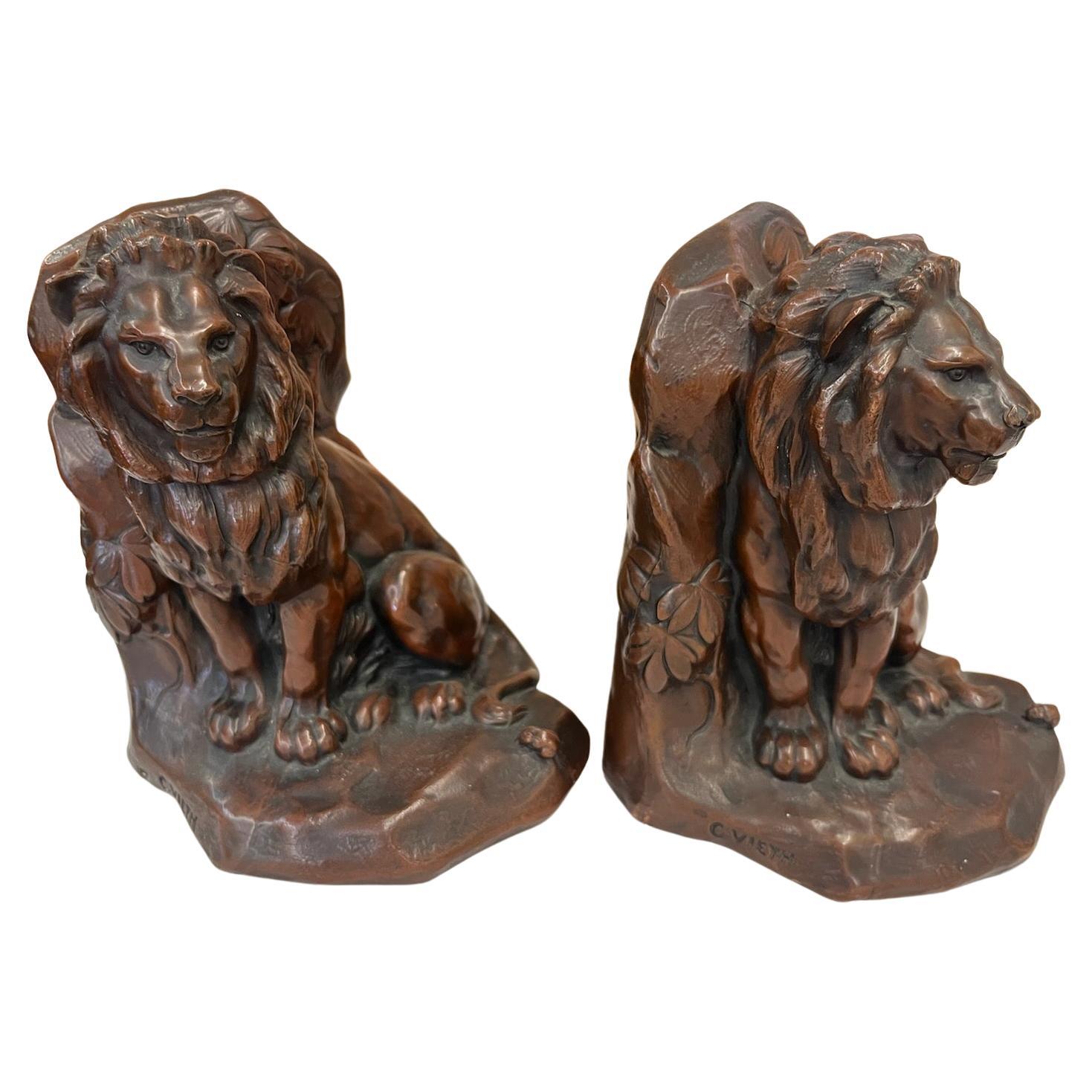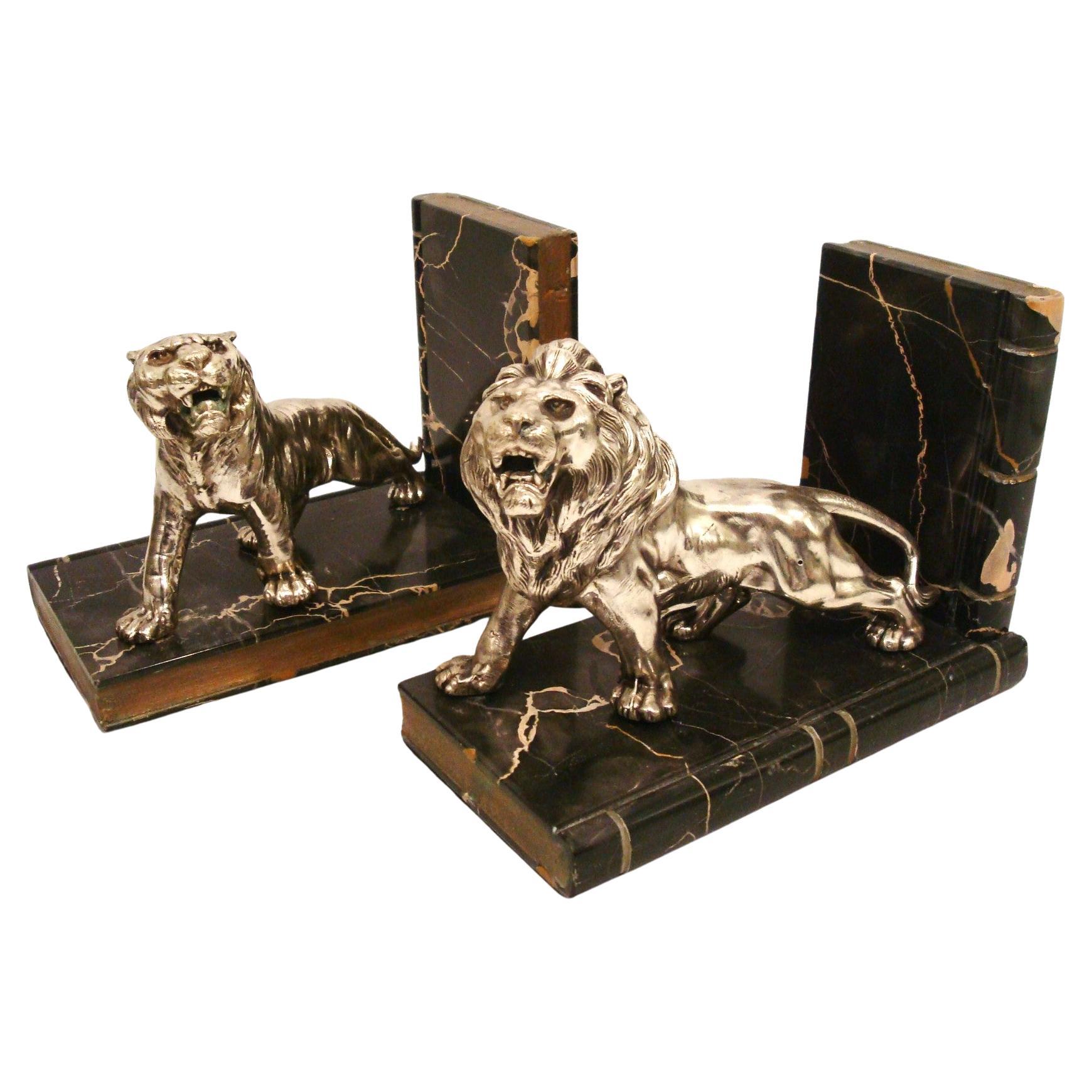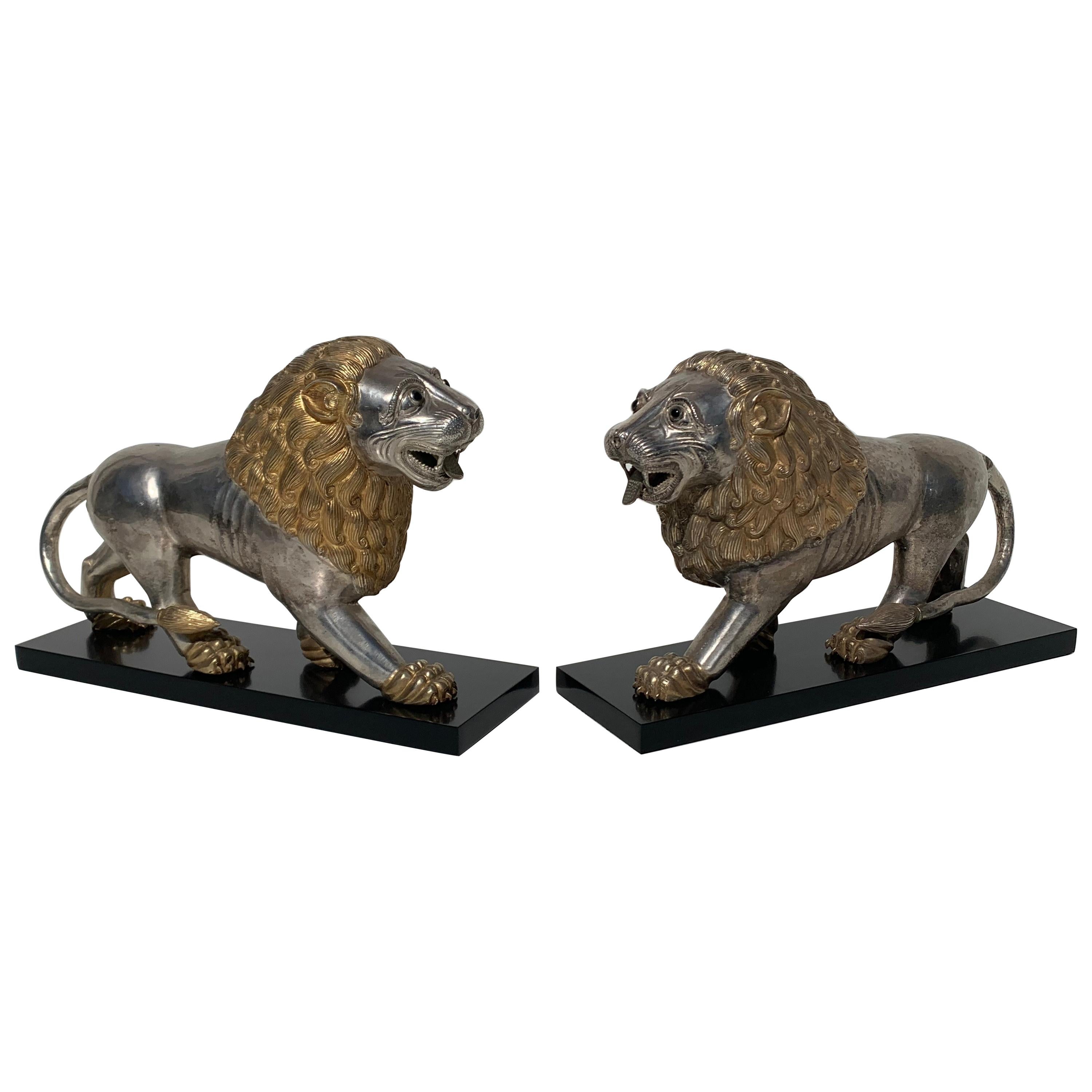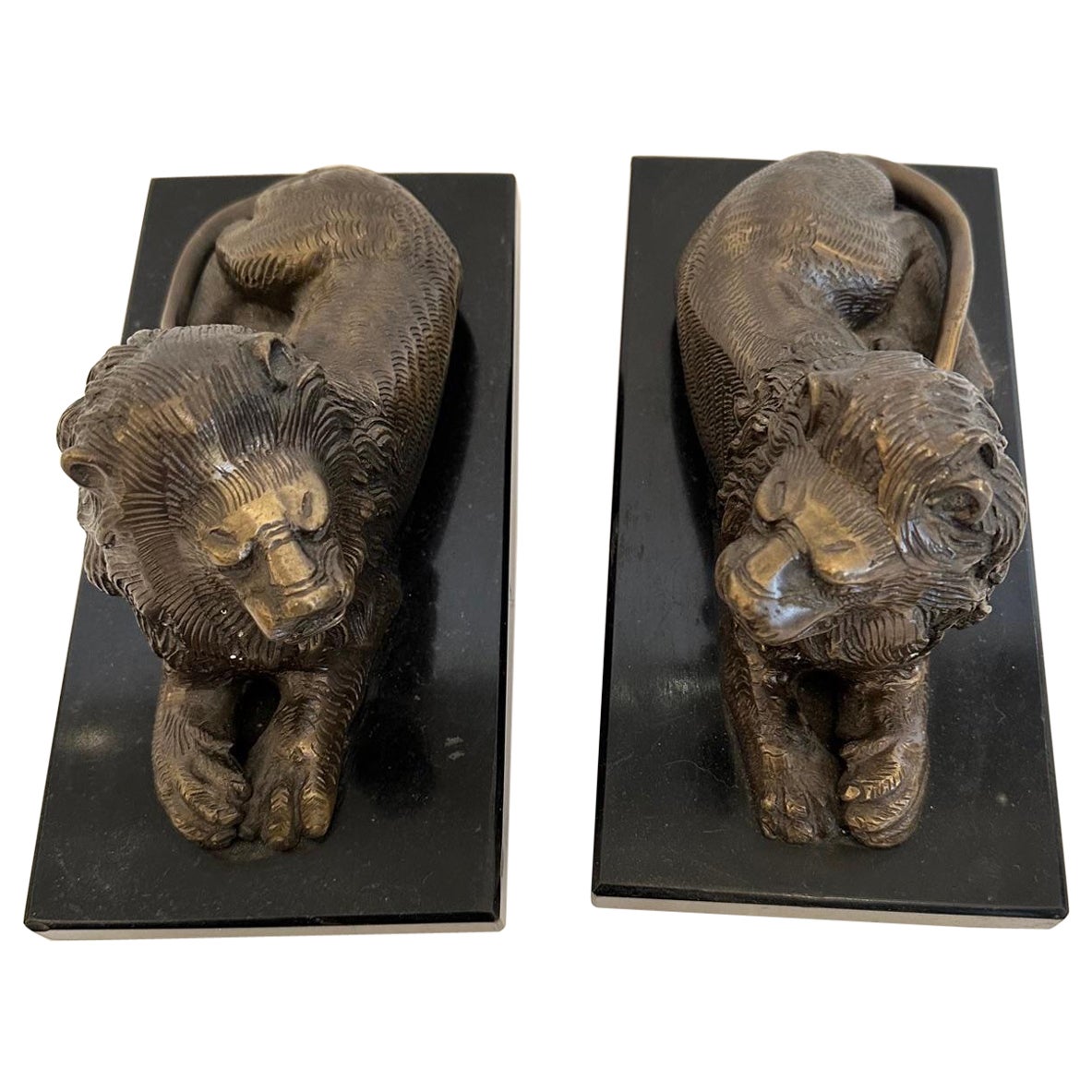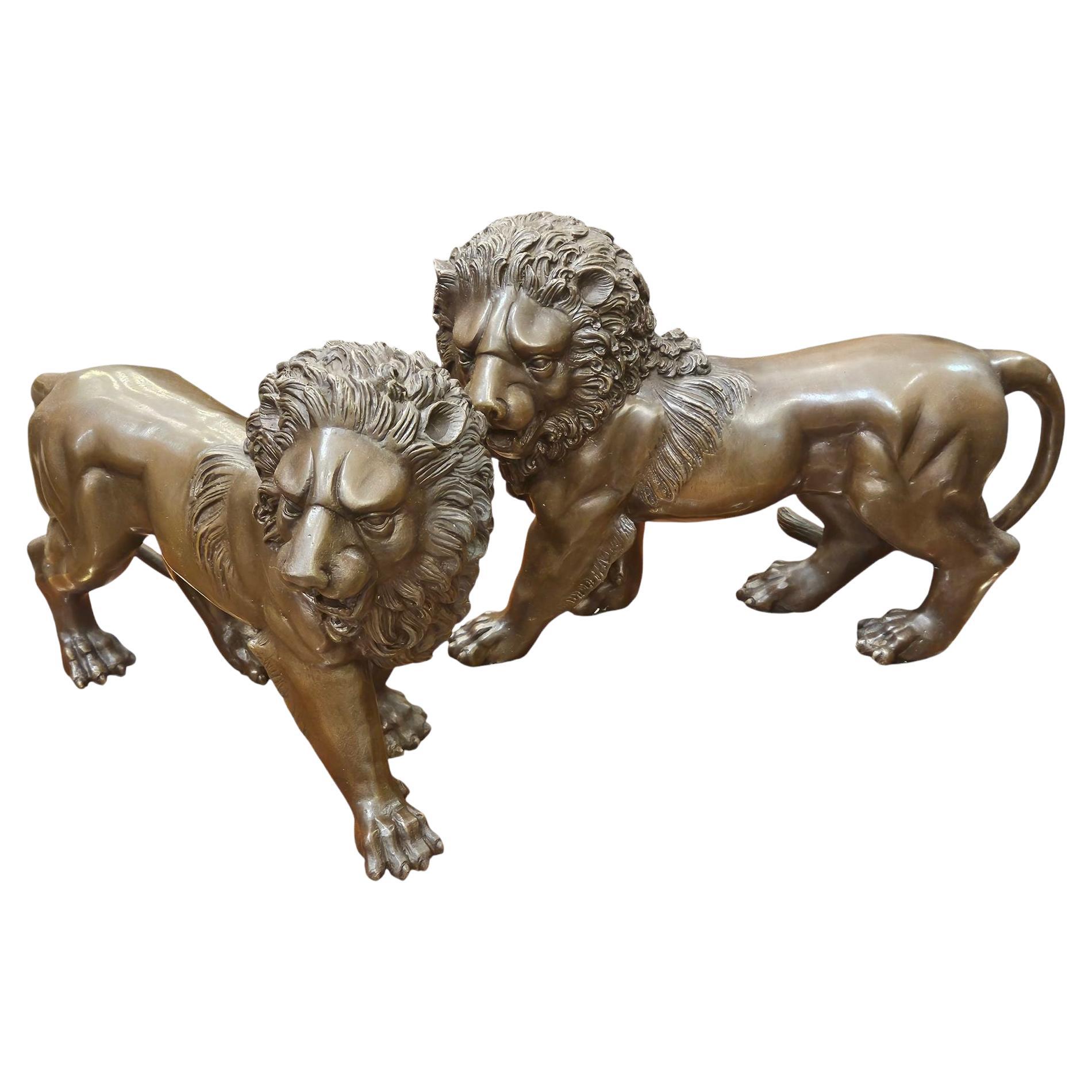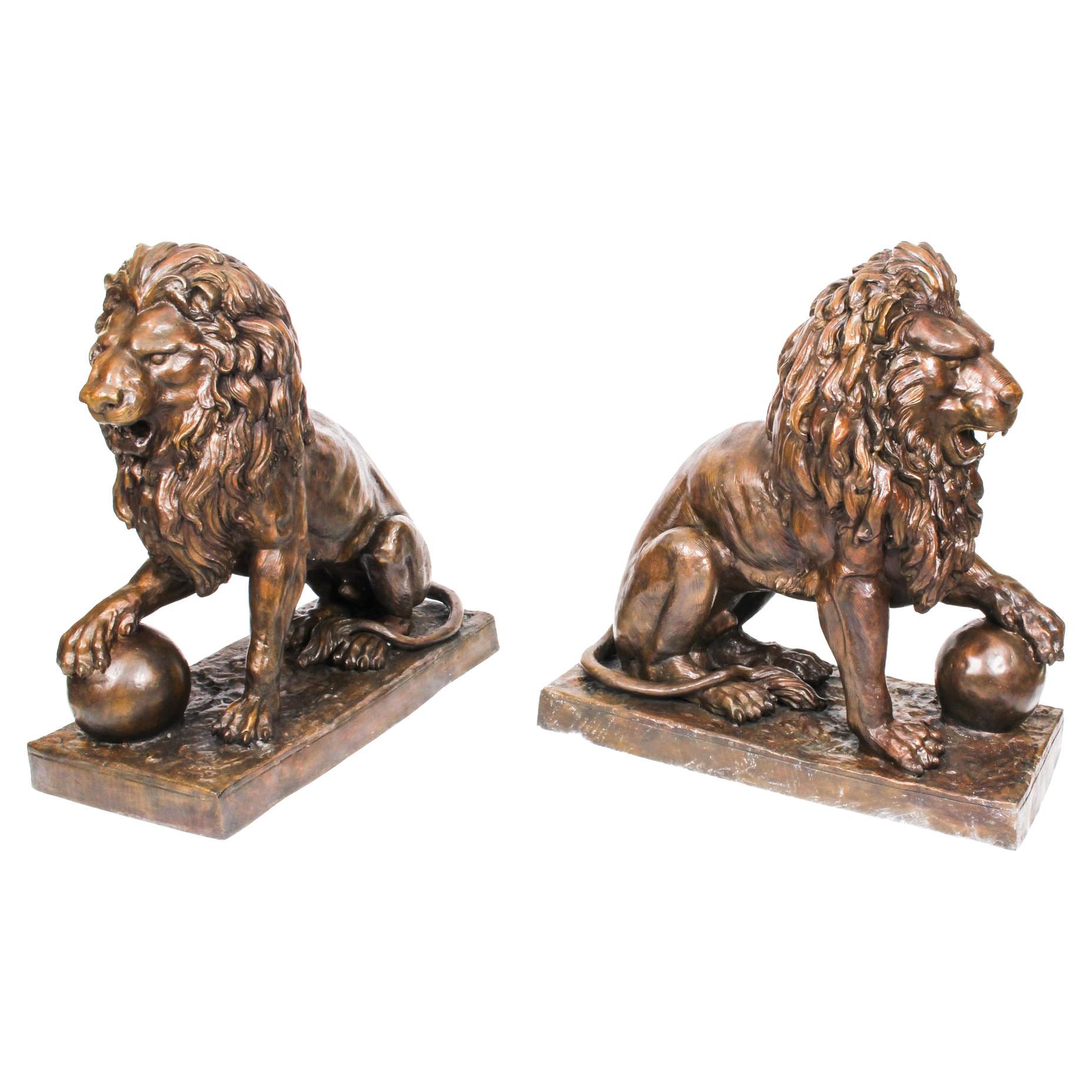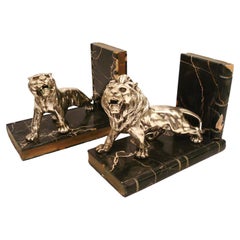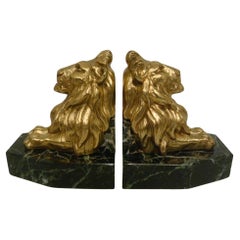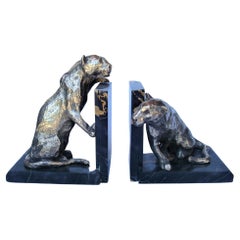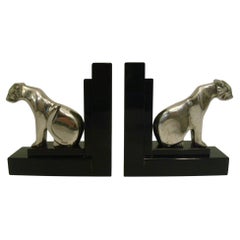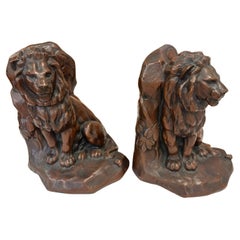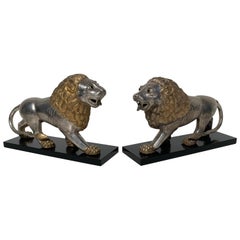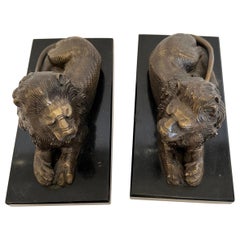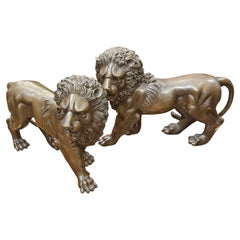Items Similar to 19th Century Pair of Japanese Bronze Lions Bookends, Meiji Period
Want more images or videos?
Request additional images or videos from the seller
1 of 14
19th Century Pair of Japanese Bronze Lions Bookends, Meiji Period
$2,600
£1,965.10
€2,264.85
CA$3,668.60
A$4,043.05
CHF 2,116.67
MX$49,661.47
NOK 26,596.45
SEK 24,892.16
DKK 16,910.31
About the Item
This superb and rare pair of Japanese Meiji period bronze bookends are cast in solid bronze and depict a pair of Lions, with their heads raised. These finely sculpted pieces are beautifully finished with great detail to the hair texture. When displayed as book supports, they look superb with a row of fine leather books resting between them. These pieces are both signed on their bases.
We have specialized in the sale of Art Deco and Art Nouveau and Vintage styles since 1995. If you have any questions we are at your disposal. Pushing the button that reads 'View All From Seller'. And you can see more objects to the style for sale. Why are there so many antiques in Argentina?
In the 1880 – 1940 there was a grate wave of immigration encouraged by the periods of war that were taking place. 1st World War took place between 1914 and 1918 2nd World War took place between 1939 and 1945 The immigrants options were New York or Buenos Aires. Tickets were cheap and in Buenos Aires they were welcomed with open arms, as it was a country where everything was still to be done. Argentina was the country of new opportunities, labour was needed and religious freedom was assured, in many cases the of the family travel first until they were settled and then the rest of the family members join them. In the immigrant museum “Ellis Island Immigrant Building” in New York you can se the promotional posters of the boats that would take them to a new life. Between the years 1895 and 1896, Argentina had the highest DGP (gross domestic product) per capita in the world according to the Maddison Historical Statistics index, this situation arose due to the large amount of food being exported to European countries, which were at war. The Argentinean ships left the port of Buenos Aires with food, but they returned with furniture, clothes and construction elements, (it´s common to see this the old buildings of the historic neighbourhood of San Telmo, the beams with the inscription “Made in England)”, as well as many markets that were built in Buenos Aires, such us the San Telmo Market, whose structure was brought by ship and afterwards assembled in 900 Defensa Street. With the great influence of European immigrants living in the country, the children of the upper classes travelled to study in France, resulting in the inauguration of “La Maison Argentinienne”, on 27th of June 1928, in the international city of Paris, which hosted many Argentinians that were studying in Frace. It´s the fourth house to be built after France, Canada and Belgium, being the first Spanish-speaking one. Still in place today (17 Bd Jourdan, 75014, Paris, France). Many of the children of these wealthy families who attended international art exhibitions, museums and art courses abroad, took a keen interest in the European style. This is why Buenos Aires was at the time referred as “The Paris of South America”. Between the years 1890 and 1920 more than a hundred Palaces were built on Alvear Avenue the most exclusive avenue in Buenos Aires. Today some of these palaces have been transformed into museums, hotels and embassies. In the year 1936, the Kavanagh building was inaugurated, it was the tallest reinforced concrete building in South America. During 1994 the American Society of Civil Engineers distinguished it as an “international engineering milestone”, and it´s now considered a World Heritage of Modern Architecture. At the time was common to hire foreign architects such as Le Corbusier, who visited Buenos Aires/Argentina in 1929 and in 1948 he drew up the blueprints for a house built in La Plata City (which was declared a World Heritage Site). In 1947, the Hungarian architect Marcelo Breuer designed “Parador Ariston” in the seaside city of Mar del Plata. After an Argentinean student at Harvard University convinced him to come to Argentina. He worked on an urban development project in the Casa Amarilla, area of La Boca. The Ukrainian architect, Vladimiro Acosta, arrives in Argentina in 1928 and worked as an architect until que moved to Brazil. Antonio Bonet, a Spanish architect who worked with Le Corbusier in Paris, arrives in Argentina in 1937, where he carried out several architectural works and in 1938 designs the well-known BFK chair. Andres Kálnay, of Hungarian origin, made around 120 architectural masterpieces, among which the former Munich brewery stands out, he even made the furniture’s design. The German architect, Walter Gropius, director of the Bauhaus, lived in Argentina, where he wrote articles for “Sur” magazine and founded in Buenos Aires, an architectural firm with Franz Möller, who was also an architect, where he built two houses. At the same time several famous designers decided to immigrate to Argentina, among them we can find the well-known French designer, Jean-Michel Frank, who arrived in the country in 1940 and also worked for the Rockefeller family. Special pieces were made, which were sold exclusively in the country, such as the well-known German company “WMF”, who sold their products by catalogue, which were chosen by the ladies of high society in the list of wedding gifts, as well as the pieces designed by Christofle. The Swiss sculptor Alberto Giacometti, made special pieces for Argentinean mansions. In 1904 the first Jansen branch outside Paris was established in Buenos Aires, as the Argentinean clientele demanded a large amount of furniture, from the end of the 19th century to the mid-20th century. In 1970, the brand Rigolleau Argentina made pieces authorised by Lalique. The brands Maple and Thompson also set up shop in the country. The French plastic artist, Marcel Duchamp moved to Argentina in 1918-1919. Glass signed Gallé, Charder, Leverre, Schneider, Muller and other French firms. They were bought in flower shops and were given to ladies with beautiful floral arrangements. Some furniture manufacturers travelled to international fairs and bough the patterns to produce the furniture in Argentina, such as the furniture firm Englander and Bonta, who bought the patterns in Italy. It is worth mentioning that in Argentina we have the largest community of Italians outside of Italy, as it is estimated that 70 percent of the inhabitants have at least one Italian descendant, followed by Spanish immigrants. The most Important furniture stores in Argentina: Comte is founded in 1934 (under the direct management of Jean Michel Frank in 1940). Nordiska (Swedish company established in 1934). Churba in 1960, a company that brought foreign designers to present their furniture in the country: Denmark: (Arne Jacobsen, Finn Juhl, Bender Madsen, Ejner Larsen, Poul Kjaerholm, Hans Wegner) Sweden: (Hans Agne Jakobsson, Gustavsberg) United States: (Herman Miller) Finland: (Lisa Johansson, Folke Arstrom, Tapio Wirkkala, Alvar Aalto, Timo Sarpaneva) Swedish Factory: (Orrefors) Italy: (Littala, Vico Magistretti, Emma Gismondi, Gae Aulenti, Angelo Mangiarotti, Elio Martinelli, Gianna Celada, Angelo Mangiarotti, Mario Bellini, Carlo Scarpa) Finland: (Olivia Toikka) Plata Lappas (Lappas Silver): a goldsmith shop founded in 1887 in Argentina by Alcibiades Lappas of Greek origin. In 2019, in Argentina took place “the Art Deco world congress” . Argentina currently has more than 100 Art Deco buildings and another 90 Art Nouveau buildings throughout the city of Buenos Aires. Argentina is a country that has not been involved in many wars, which is why it has been a refuge for works of art and antiques from different periods of time, unlike European countries. That is way many collectors, museums and antique dealers from all over the world visit it, you should not miss the opportunity to visit this great country.
- Dimensions:Height: 5.52 in (14 cm)Width: 5.2 in (13.2 cm)Depth: 4.73 in (12 cm)
- Style:Meiji (Of the Period)
- Materials and Techniques:Bronze,Cast
- Place of Origin:
- Period:
- Date of Manufacture:1870-1910
- Condition:Wear consistent with age and use. Slight Time wear.
- Seller Location:Buenos Aires, AR
- Reference Number:1stDibs: LU2027333731422
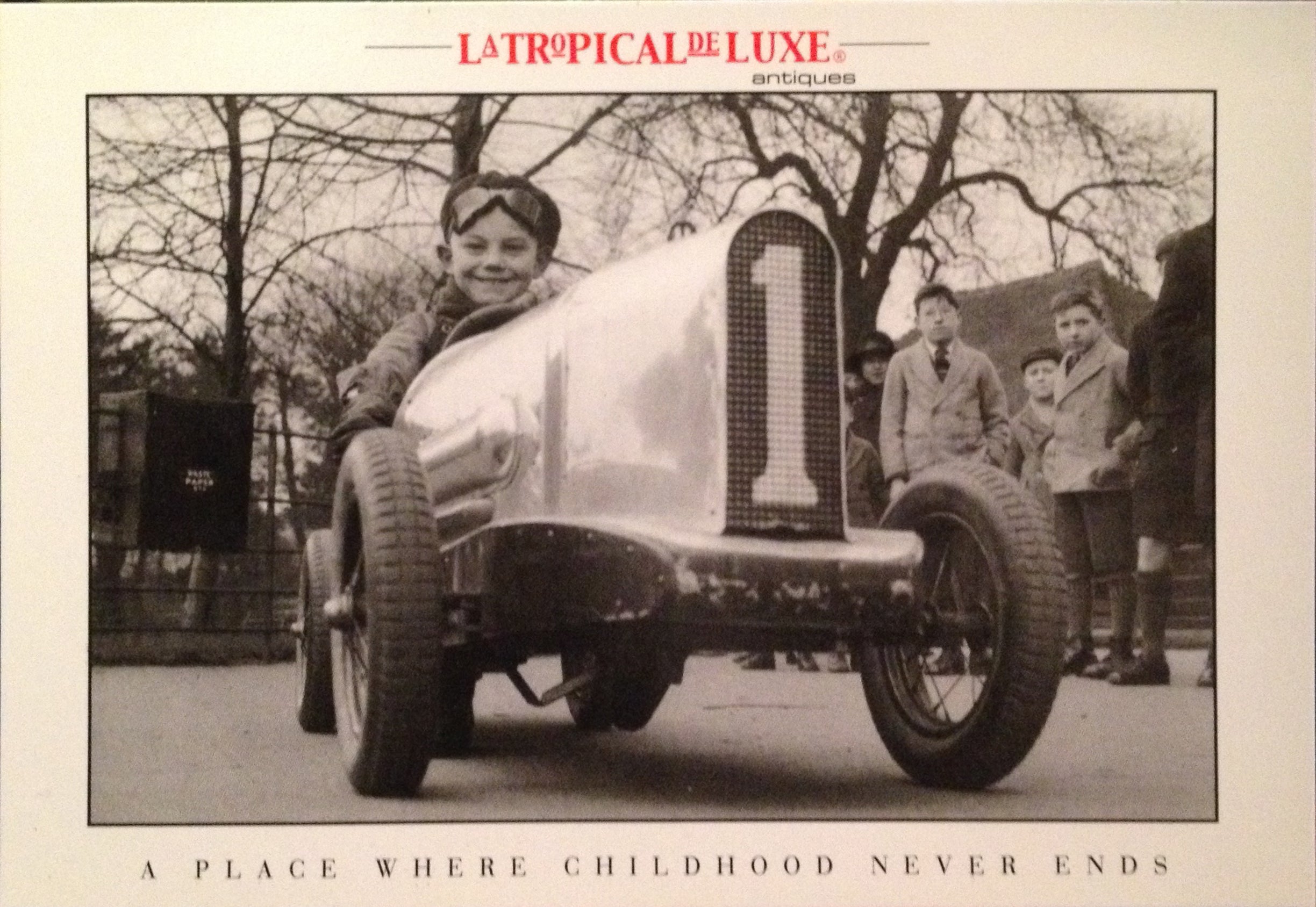
About the Seller
4.9
Vetted Professional Seller
Every seller passes strict standards for authenticity and reliability
Established in 2002
1stDibs seller since 2016
322 sales on 1stDibs
Typical response time: 1 hour
- ShippingRetrieving quote...Shipping from: Buenos Aires, Argentina
- Return Policy
Authenticity Guarantee
In the unlikely event there’s an issue with an item’s authenticity, contact us within 1 year for a full refund. DetailsMoney-Back Guarantee
If your item is not as described, is damaged in transit, or does not arrive, contact us within 7 days for a full refund. Details24-Hour Cancellation
You have a 24-hour grace period in which to reconsider your purchase, with no questions asked.Vetted Professional Sellers
Our world-class sellers must adhere to strict standards for service and quality, maintaining the integrity of our listings.Price-Match Guarantee
If you find that a seller listed the same item for a lower price elsewhere, we’ll match it.Trusted Global Delivery
Our best-in-class carrier network provides specialized shipping options worldwide, including custom delivery.More From This Seller
View AllPair of French Lion and Tiger Bookends
Located in Buenos Aires, Olivos
Pair of French Lion and Tiger Bookends
A pair of bookends. Each bookend features a metallic sculpture of a big cat, with one being a lion and the other a tiger. The sculptures are mo...
Category
Early 20th Century French Empire Animal Sculptures
Materials
Marble, Metal
$1,700 / set
Gilt Bronze Guardian Lions Bookends. Signed H. Payen, France 1920´s
By H. Payen
Located in Buenos Aires, Olivos
Gilt Bronze Guardian Lions Bookends. Signed H. Payen, France 1920´s.
Fantastic Pair of Lion Bronze sculptures, mounted over marble bases.
Very Good confitions.
We have specialized ...
Category
Early 20th Century French Art Deco Animal Sculptures
Materials
Marble, Bronze
Art Deco Silvered Bronze Lioness Figures Bookends by Roger Godchaux
By Godchaux
Located in Buenos Aires, Olivos
Roger Godchaux (1878 - 1958): two lioness figures / sculptures
Silvered bronze mounted as bookends on marble plinths; both with plaque to base inscribed "Godchaux Sclp./ Susse Fres...
Category
Vintage 1930s French Art Deco Animal Sculptures
Materials
Marble, Bronze
Art Deco Silvered Bronze Tiger Bookends - France 1930´s
Located in Buenos Aires, Olivos
Art Deco Silvered Bronze Tiger Bookends - France 1930´s
Tigers are mounted over Belgium Black Marble.
We have specialized in the sale of Art Deco and A...
Category
Mid-20th Century French Art Deco Bookends
Materials
Belgian Black Marble, Bronze
Art Deco Pair of Panther Bookends, Silvered Bronze and Marble - France, 1920s
By Paul Jouve
Located in Buenos Aires, Olivos
Art Deco pair of panther bookends. Silvered bronze and marble. Made in France, 1920s. Both stamped France. Heavy marble bookends.
In the style of Paul Jouve. They will give a chic lo...
Category
Early 20th Century French Art Deco Bookends
Materials
Marble, Bronze
$2,999 / set
Free Shipping
Antique Pair Of American Buffalo Bison Bronze and Marble Bookends 1920´s
Located in Buenos Aires, Olivos
Antique Pair Of American Buffalo Bison Metal Bookends.
Excellent details Bronze Sculptures, mounted over marble base.
Excellent condition.
We have specialized in the sale of Art Dec...
Category
Early 20th Century French Art Deco Bookends
Materials
Marble, Bronze
$1,199 Sale Price / set
33% Off
You May Also Like
Pair of Signed Bronze Lion Bookends, Circa 1900
Located in Los Angeles, CA
Pair of lion Bronze bookends with great weight lions are well proportioned. Great patina from age.
Category
Early 20th Century American Adirondack More Desk Accessories
Materials
Bronze
$716 Sale Price
20% Off
Pair of Silvered Brass Anglo Indian Lion Sculptures Bookends
Located in North Hollywood, CA
Pair of silvered brass Anglo Indian guarding lion sculptures or bookends.
Category
Antique Mid-17th Century Anglo-Indian Animal Sculptures
Materials
Brass
$2,600 Sale Price / set
20% Off
Pair of Bookends Having Recumbent Bronze Lions on Belgian Slate Bases
Located in Hopewell, NJ
Handsome pair of bookends or desk accessories having recumbent bronze lions on belgian slate bases.
Category
Vintage 1960s French Bookends
Materials
Slate, Bronze
Pair of Bronze Medici Lions
Located in London, GB
A Lovely Pair of Medici Bronze Lions
Lovely Patina and Definition
C20th
Category
Late 20th Century Unknown Renaissance Animal Sculptures
Materials
Bronze
$963 Sale Price / set
20% Off
Vintage Magnificent Large Pair of Cast Bronze Medici Lions Late 20th Century
Located in London, GB
This is a historically interesting bronze sculpture of a pair of lions after the original Medici Lions placed at the Villa Medici, Rome. This pair dating from the second half of the 20th Century.
The lions are sitting on their haunches with one front paw on a sphere, and they are facing right and left with their tails on opposite sides. They feature beautifully toned muscles and sleek detailed manes, which signifies their masculinity and reflects their health.
This high-quality hot cast solid bronze pair was produced using the traditional "lost wax" process, otherwise known as the "cire perdue" method.
It is a majestic pair which will look lovely equally at home indoors or outdoors.
Condition:
In excellent condition, please see photos for confirmation.
Dimensions in cm:
Height 96 x Width 43 x Depth 95
Dimensions in inches:
Height 3 foot, 2 inches x Width 1 foot, 5 inches x Depth 3 feet, 1 inch
Lost Wax Method
sometimes called by the French name of cire perdue or the Latin, cera perduta is the process by which a bronze or brass is cast from an artists sculpture.
In industrial uses, the modern process is called investment casting. An ancient practice, the process today varies from foundry to foundry, but the steps which are usually used in casting small bronze sculptures in a modern bronze foundry are generally quite standardised.
The Medici lions are a pair of marble sculptures of lions, one of which is Roman, dating to the 2nd century AD, and the other a 16th-century pendant; both were by 1598 placed at the Villa Medici, Rome. Since 1789 they have been displayed at the Loggia dei Lanzi in Florence. The sculptures depict standing male lions with a sphere or ball under one paw, looking to the side.
Copies of the Medici lions have been copied and publicly installed in over 30 other locations, and smaller versions made in a variety of media; Medici lion has become the term for the type.
The Albani lion, a similar ancient sculpture, now at the Louvre
A similar Roman lion...
Category
Vintage 1970s Animal Sculptures
Materials
Bronze
Set of Art Déco Bronze and Marble Lions Couple Bookends by Émile Carlier, France
By Émile Nestor Joseph Carlier 1
Located in North Miami, FL
Pair of early 20th century Art Déco bronze and marble lions couple bookends by Émile Carlier, France
By: Émile Nestor Joseph Carlier
Mater...
Category
Vintage 1920s French Art Deco Bookends
Materials
Stone, Marble, Metal, Bronze, Copper
More Ways To Browse
Mid Century Danish Directors Chairs
Japanese Seller
Pair Of Greek Sculptures
Japanese Solid Silver
Japanese Lion
Meiji Bronze Sculptures
Japanese Shop Sign
Jansen Book
Paris Bookends
Lion Head Chair
Marcel Breuer Book
Jean Michel Frank Book
Glass Lion Sculpture
Lalique Head
Hair Posters
Lion Sculpture Pair French
Jean Michel Frank Leather Chair
Meiji Bronze Animal
